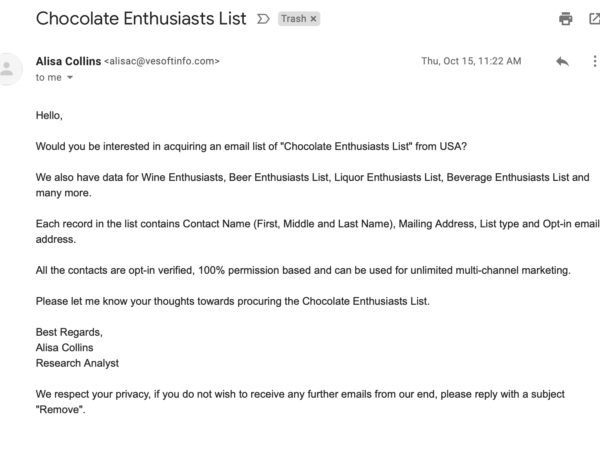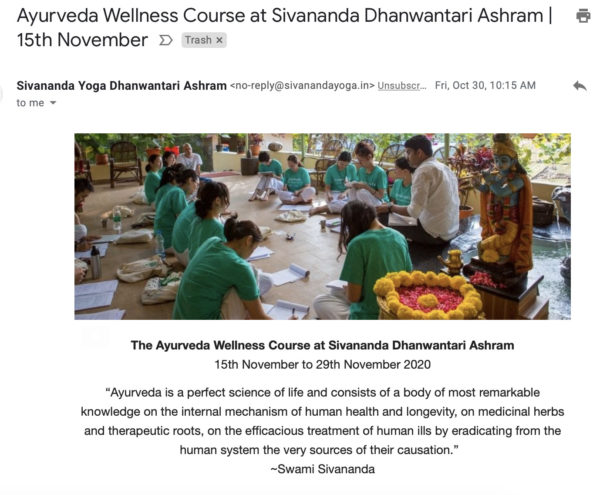We’ve all made email marketing mistakes: You click send on an email and suddenly your stomach drops. You’ve made a mistake and there’s nothing you can do about it. Your email is out in cyberspace, and soon you’ll have to deal with the consequences.

Some errors are obvious and a major misstep could instantly negate all the hard work you’ve put into your email marketing campaign. Other faults are just as bad, but not necessarily something you’ve even considered. You may not even be aware of some email marketing mistakes you’ve committed.
If it’s so easy to make a mistake, why use email marketing? Well…
Because email users include more than 4 billion people across the globe, email marketing remains one of the most effective and affordable means of connecting with your current and prospective customers. Email is also often more affordable than paid social media advertising strategies, as it delivers the best return on investment (ROI). Forbes recently reported on an email marketing study that showed a $36 return for every dollar spent.
Therefore, it shouldn’t come as a surprise that in 2020 and 2021, email has continued to be a strong marketing channel. And with the rise of COVID-19, more brands have incorporated or increased their focus on email as a way to keep in touch with their audiences.
And that’s great! Until a mistake happens. And the consequences of an error can multiply when they go out to thousands of people in the blink of an eye.
Knowing what email marketing mistakes to look for will help you create professional company emails, connect successfully with your current customers, and bring in more prospects for future growth.
This massive guide includes 40 email marketing mistakes to avoid:
- Skipping the planning process
- Building your email list improperly
- Crafting a boring email
- Neglecting email system backend best practices
- Not taking advantage of technology
- Causing headaches for the recipient
- Sending from a confusing email address
- Triggering SPAM filters
- Setting it and forgetting it
- Ready to learn more about email campaigns and digital marketing?
Soon, you’ll learn which common email mistakes to look for as you begin or refine your marketing campaigns. To keep those worrisome knots out of your stomach as you hit the send button, keep reading.
Skipping the planning process
You increase the chances of making common email mistakes when you skip the most important step: planning.
1. Creating newsletters without an outline
Annually or at the start of every quarter, you should sit down with a team of stakeholders or decision-makers to review your digital marketing plan. Part of this meeting should include brainstorming the messages and timelines of your email campaigns.
It’s common for small business owners to believe they don’t have the time to invest in this process, but a lack of planning will hold up everyone’s schedules even more.
Think about it: If you’re busy now, you’ll probably also be busy when it’s time to send out that important company email. There’s nothing worse than having to scramble at the last minute to come up with ideas to share with your customers.
2. Not defining your target audience
Having a clear understanding of your brand identity will help you hit the mark with your campaigns and avoid email marketing mistakes. Here’s the first branding question a seasoned marketing professional will ask their clients: Do you know your target audience? And while it’s good to have a big vision for success, the reality is that you must refine your audience.
When creating a buyer persona — a representation of your ideal customer — think deeper than demographics like age, gender, and geography. What are your ideal customer’s hobbies, habits, needs, and values? The more you can visualize who is receiving your email, the more likely you’ll succeed in your goals.
3. Not having measurable goals
Speaking of goals, every successful email marketing campaign has them. When you’re not clear on what you wish to accomplish, you’re sure to make mistakes.
Make your goals SMART: specific, measurable, assignable, relevant, and time-based. For email marketing, your goals can focus on:
- Deliverability, or the rate that your emails reach the right inbox
- Open rate, or the percentage of people that open your emails
- Click-through rate (CTR), or the percent of people that click on links in your emails
- Unsubscribes, or the number of people who opt out of receiving your emails
When choosing your goals, it helps to look at available email marketing data. Compare how your emails are performing with your industry’s average metrics to help you assess what needs improvement.
Building your email list improperly
Once you’re done with the planning process, you can start implementing it. But you won’t find much success if you haven’t been collecting email addresses to receive your marketing messages. Be wary of the ways you can do so — some of the most crucial email marketing mistakes to avoid involve this step.
4. Buying email lists
This is the fastest way to get your email account flagged. Not only will your email service penalize you, but you’ll be violating the rules of consent under the EU’s General Data Protection Regulation (GDPR) and Canada’s Anti-Spam Legislation (CASL). This data privacy act dates back to May 2018 for all European accounts. If you have any European email addresses on your list, you must comply with this act.

Besides being illegal in some countries and against the terms of service for most email providers, it’s important to remember that the people who own email addresses from a purchased list won’t have a relationship with the list buyer and cold emails are rarely effective. Should you go down this route anyway, you risk annoying potential customers and ruining your otherwise good reputation.
5. Not asking permission before creating email lists
Just because someone gave you or your associates a business card three years ago doesn’t mean they’re permitting you to sign them up for your newsletter. This is one of the most common email marketing mistakes that small business owners make when building their initial email lists.
However, if your business still has a relationship with these people, you can certainly ask them to opt into your email list. This is a respectful way of inviting someone to learn more and engage, rather than presuming that they want to be on your list.
6. Using complex opt-in forms
Including an email sign-up form on your website isn’t a bad idea, but avoid making too many questions mandatory. Instead of gathering a ton of information to find out what the recipient is interested in, include quick and clickable checkboxes. They’ll know what they’re signing up for and feel empowered as a result.
7. Not offering lead magnets
A lead magnet is something of value that potential subscribers may download for free when they sign up and provide you their email address and other details. Examples of lead magnets include:
- Whitepapers
- Infographics
- Ebooks
- Checklists
- Templates
- Webinars
This is a win-win. Your prospect will get a valuable product or service for free, and you’ll be able to follow up and strengthen your relationship. That’s the best way to convert qualified leads into loyal customers.
8. Not including a share button
At the bottom of every email you send, make sure to include a button that lets the recipient forward the message with a quick click of the mouse. When they use this, your customers become informal brand ambassadors that will help you grow your email list organically. The more people share your emails, the more you know you’re providing value.
Crafting a boring email
If your recipient can’t tell what you’re trying to express — or if they simply don’t care to find out — you’ve likely committed some email marketing mistakes.
9. Creating unfocused emails
You may have a measurable objective to determine the success of your email campaign, but how are you getting there? You should be able to explain how every element of an email is helping to strengthen relationships, provide support, or offer value to the recipient. Don’t just send an email to “connect.” Have a clear reason for taking up precious space in your subscribers’ inboxes.

Look at the big picture when creating an email for your customers or stakeholders. What is the message you’d like them to take away from the email? If it’s not clear to you, it won’t be clear to them, either.
10. Forgetting your call-to-action
When it comes to marketing messages, people need to be told exactly what you want them to do before they do it. That’s why you must always include a call-to-action (CTA) — common examples of this include:
- “Buy Now”
- “Click Here to Learn More”
- “Shop Today”
- “Register Today”
You can be more creative with your CTAs, but never forget to include at least one in every email you send.
11. Using the wrong template
Take time when choosing templates for the various emails you’ll create as part of your marketing campaigns. You’ll likely use the same ones over and over again. Templates are excellent tools for saving time and looking professional, but not if you pick the wrong ones.
For example: A childcare facility would respond better to a much different email design than one that would engage a law office. This is why it’s so important to deeply understand your ideal customer. Browse the templates designed for your industry and pick ones that align with your email marketing goals.
Neglecting email system backend best practices
Unless you’re a seasoned marketing professional, the backend of your systems may at first seem overwhelming. But if you don’t take the time to input data and organize your contacts properly, you can run into email marketing mistakes when you start sending out campaigns.
12. Sending “Dear First Name Last Name” messages
You know what they say: Garbage in, garbage out. If you don’t clean up your contact lists regularly, you risk sending email duds. If you want to address your recipients by name, you’ll need to make those fields mandatory in your opt-in form.
13. Not personalizing at all
You may think that the solution to not knowing your contacts’ names is to not personalize your emails at all — but this would be a mistake. Personalization is an important email marketing strategy. It improves your open rate and other important metrics.
Along with adding at least a first name to your initial greeting, try including these in your emails:
- Specific and localized details
- Information based on whether or not your customer has purchased a product
- Personal events, such as birthday or holidays
- CTAs that are relevant to your customer
- An image of your signature, rather than a company logo
14. Including the same content for different segments
You’ve got your email list filling up the right way, and you’ve double-checked to make sure that subscriber data is being added correctly. That’s great! But, if you have just one big list, you’re committing yet another email marketing error. You should be sending different emails to different email segments.
Think about the different audiences you are addressing with your emails and create a sub-list for each one. Consider segmenting beyond simple demographics. You might want to categorize by marketing-specific details like website activity or engagement level.
15. Not cleaning out your email lists regularly
More is not always merrier when it comes to email lists. You shouldn’t keep people on your list simply to increase your total numbers. Instead, remove the email addresses of people who aren’t engaging. Cleanse your list regularly of emails that have hard-bounced so that you don’t keep sending marketing messages to dead accounts.
TIP: If you find contacts on your email list who are receiving your email campaigns, but not opening them, think about sending them an email that’s specifically designed to re-engage them with your business.
Not taking advantage of technology
One of the benefits of modern email marketing is the ability to use technology to your advantage. Save yourself time by automating some tasks with online tools designed specifically to make your job easier.
16. Not sending a welcome email
If someone signs up for your email list, it’s a mistake to not immediately welcome them. Of course, you can’t drop everything simply because someone signed up. However, you can set things up so your email marketing platform knows to automatically send a welcome message right away.
Should your opt-in form include allowing the recipient to sign up for a specific segment, you’ll be able to personalize this welcome message with an offer they’ll care about. If not, don’t worry. A simple hello is all that’s needed to begin the engagement you seek to cultivate.
17. Not using autoresponders
A welcome message isn’t the only automated email you should consider setting up. Sometimes referred to as an email drip campaign, an autoresponder is a series of emails that can be sent out automatically in response to a wide range of actions.
For example: If someone downloads a free guide you’ve put up as a lead magnet, you can first welcome them to your mailing list — with the option of opting out, of course. A few days later, you can send a follow-up email with specific advice or opportunities that directly relate to the content of the free guide.
Since they’ve already expressed interest, they will likely appreciate the follow-up. Perhaps you can send a coupon for future purchases, too.
18. Not asking to get on the safelist
A clear demonstration that you’ve made some email marketing mistakes is when your messages wind up in a junk folder. To avoid being blocklisted, ask your email recipients to include you in a list of their approved senders. This is known as getting on the safelist. You may also include directions for adding your email to a reader’s contact list in your welcome email.
19. Not having your emails optimized for mobile
More people are checking their emails on their mobile devices these days. You’ll want to make sure that you’re using mobile-responsive message templates.
Think about it: You don’t want to make your prospects have to tilt their smartphones or heads sideways to read your email. It’s too much work. They’re more likely to simply delete a message from you that’s hard to read — and then unsubscribe.
Causing headaches for the recipient
Email errors are always embarrassing, but you’re more likely to hear about them if you’ve annoyed your recipients. Double-check for these common mistakes to avoid causing headaches for your customers and prospects.
20. Sending too many messages
Do you really have that much to share? Even during the busiest times — like the holiday season — you shouldn’t be bombarding people’s inboxes with your emails. That’s why it’s so important to create a timeline before you begin your campaign.
By thinking ahead, you’ll be able to consolidate your news so that you’ll send emails less frequently. It’s better to be consistent — whether you’re sending something once a week or once a month — rather than a lot at once.
TIP: While frequent, short (one-subject) emails can be great for retail, most businesses only need to send out an email campaign once a month to stay top of mind with their customers. However, only you can decide what frequency is best for your business. But no matter what you decide, stay consistent.
21. Not checking for errors
Are you satisfied with the copy, images, and design of an email you plan to send? Send a test copy to yourself to make sure. But before you proofread your work, consider getting up and clearing your head. It’s hard to edit yourself, but it’s perhaps the most important thing you can do to avoid typos and minor errors.
To catch email marketing mistakes early, you may also send a test copy to someone else on your team. The more eyes on your work, the better. Be open to criticism — if someone is confused by an email, it’s likely they won’t be the only one.
22. Adding low-resolution images
Pixelated, stretched, or otherwise unattractive images look unprofessional and detract from your message. It’s better to work with a high-resolution image and downsize, if necessary. A low-resolution image can’t get any crisper.
23. Adding images that are way too big
You don’t want to include images that are too large, either. In general, try to have your images be around 1 MB so that the entire email is less than 2 MB.
Think you’ve inserted a good-sized image? Does it load just fine in the test message? Still not sure if your image is too big? Add a proper description of your image in the alt text section, so your recipients will know what the image is even if it doesn’t load.
24. Clogging inboxes with attachments
When you receive an email from a company with an attachment, what’s your first thought? Many people will think it’s SPAM — or worse, a virus.
There’s little reason to include an attachment on an email that’s sent to an email list. Even if the recipient trusts you, it’s not polite to clog their inbox with large attachments when you could simply link to the material.
If you’d like to include valuable information or documents in your marketing email, do your recipients a favor and upload the file to a cloud-based service instead. Include a link for them to access it online or download at their convenience. Your emails will look more professional and trustworthy.
25. Not checking your links
Broken links are the worst. What good is your email if you encourage people to click on a link that doesn’t work or one that leads them to the wrong page? Always double-check every link before sending any email.
26. Sending placeholder text
This is one of the most embarrassing email marketing mistakes you can make — and it’s completely avoidable. Placeholder text is an excellent tool to expedite workflow because you can work on the design and copy of an email in draft form. For example: If you’re waiting for approval on pricing, you may write “INSERT PRICE HERE.”
You may be surprised how common it is for emails to be sent before the placeholder text is replaced with the correct information. Don’t let it happen to you. Always proofread and double-check your work.
Sending from a confusing email address
People are less likely to open an email if it’s not clear who’s sending it. Avoid confusion and annoyance among your subscribers by choosing the right email address to send from.
27. Using your personal email service
While it’s not always a bad idea to send an email from a business email address with the name of the owner or marketing director, you should never send business emails from a personal account.
Your personal Gmail or Yahoo email accounts can cause confusion. It doesn’t matter if you have a small business. Invest in an email address that is clear and professional.
28. Not being transparent as the sender
There are other ways besides setting up a clear email address to be transparent as the sender. Lacking transparency is a critical mistake to avoid because you risk violating the 2003 Controlling the Assault of Non-Solicited Pornography and Marketing (CAN-SPAM) Act.
Be sure to include your company name and business address in every email so there is no confusion.
29. Not making it easy for your subscribers to reply
Let’s say a company sends an email, and a subscriber wants to engage for whatever reason. What if they can’t simply hit the reply button to begin a conversation? When someone’s forced to search through a company’s website to find a way to connect, chances are high that they’ll be annoyed and less likely to engage in the future.
Use a real address not just for the “From” section, but also for the “Reply” section of your email. If the replies become too cumbersome, you can integrate a “Contact Us” link within your email to send potential leads to a helpful landing page.
30. Hiding the unsubscribe button
Do you make the unsubscribe link the same color as the background or use a ridiculously small font? This trick doesn’t work. In fact, it’s a big error. You should consider it a gift when people look to unsubscribe from your emails. They’re letting you know that they’re not part of your target audience, or they’re telling you that you need to improve your email messaging.
Instead of making the unsubscribe button hard to find, put it front and center at the bottom of every email. This reduces the frustration of your recipients, which is something you should always strive to do.
Triggering SPAM filters
We’ve already covered one common technique that can trigger SPAM filters — not being transparent as a sender. But there are so many more email marketing mistakes you can make that can cause either the email provider or your customers to mark your marketing emails as SPAM. So it’s worth it to make sure you understand how to avoid emails going to spam.
31. Adding a subject line with three exclamation points
We get it. You’re excited about your new product launch. But typing more than one exclamation point in a subject line — or anywhere in your email, honestly — could make you come across as immature. Your products and services will either be exciting or not.
Along with getting your punctuation under control, steer clear of buzzwords in your subject lines. Today’s email recipients are likely tired of clickbait-style headlines that promise to blow your mind. Be purposeful and honest instead.
32. Using ALL CAPS
Even if you want to scream your good news from the mountaintops, writing in all capital letters is not the way to do it. Why? Because your email is likely to be caught in SPAM filters. Your customers might never see it until they clean out their junk folders.
Get caught up on current SPAM trigger words so you know what else to avoid in your subject lines. Yes, you may think your customers will “be amazed” and you may want them to “call now,” but do you really want to sound like a late-night infomercial?
33. Selling way too hard
Even if you avoid trigger words and extra exclamation points, it’s still possible to miss your target with your email marketing if you aren’t careful with your content.
Let’s say you send an email and then cut-and-paste the exact email to send again. That’s an easy way to get caught in a SPAM filter and annoy your recipients. To avoid this mistake when you have a legitimate reason to resend an email, change the subject line so your customers understand why you’re sending it twice.
34. Not staying on brand
If your company is known for certain products, services, and values — or a specific brand voice — stick to them. There’s a reason you’ve created a brand identity. Consistency is important for creating loyalty. Going off-brand in emails is a big mistake.
It’s okay to shake things up a bit, but you should always make your target audience a priority in your decision-making process. Will they appreciate your email or will they be confused by it? Some SPAM blockers can detect the content of images, as well. Avoid problems by staying on brand.
35. Using cheesy stock images
The last thing you want is for your email to look outdated and off-brand. And while some stock images will be exactly what you need, it’s important to be careful with stock images. It’s too easy to use something that “will work” instead of using exactly what you should.
Consider hiring a professional photographer to help you create a portfolio of appropriate images that are unique, honest, and authentic. You’ll be able to use the images on your website, your social media, and in your email marketing campaigns.
TIP: If hiring a professional photographer isn’t in your marketing budget, many smartphones take great photos that will work almost as well. Just be sure to think like a professional when you take and edit the photos so you’re sure they’re relaying the image you really want them to.
36. Making your designs too busy
Is it hard to read the content of your email because the colors are too vibrant? Maybe there are also too many images to distract your subscribers from the copy. When in doubt, in terms of design or otherwise, remember to KISS — keep it simple, smartypants.
Setting it and forgetting it
Once you’ve set up your email automation and created a marketing plan, you might think you’re done — but that’s just the beginning. It’s a mistake to run on autopilot. Understand that all plans should be dynamic and should be adjusted based on whether or not you’re reaching your goals.
37. Not monitoring your metrics
Remember those SMART goals you created? Keep tabs on how you’re doing. Don’t wait until it’s too late to change your strategy. It can take different methods before you find one that works. And what works best today may not be what will work best tomorrow. So, keep on top of your metrics and keep trying new things to keep up with what works for your business.
If one of your goals is increased sales, it’s also a mistake if you don’t have enough inventory to meet the demand. Talk with your team before you make any big announcements so you can deliver what you promise, every time.
38. Not conducting A/B testing
If you’re not seeing the results you seek with your email marketing campaign, you know that something isn’t working. The way to figure out what’s wrong and how to correct it is through a process known as A/B testing.
In short, you’ll create two different subject lines or even two different email campaigns and see which one has better engagement. That’s how you’ll know where to put your time and resources.
39. Sending your emails at the wrong time
Sending emails at midnight or Sunday afternoons? Bad move. Review your send history and open reports to learn the best time to send emails so your customers will read and engage with your marketing messages.
40. Being out of touch
Things can get busy. But that’s no excuse to stop sending emails with the same frequency you once did. Even in slow seasons, there should be discounts and industry news you can share with your connections that will keep you top-of-mind. Consistency is key, so stay on track with your marketing plan to get the results you seek.
Ready to learn more about email campaigns and digital marketing?
Now that you’re aware of the common email marketing mistakes to avoid, it’s time to create marketing campaigns. And remember: Even if you know how to do something right, you’re not perfect — no one is. As an additional step to make sure you’re sending the best marketing emails you can, always check for errors.
You can learn how to make your digital marketing plan more robust, too. Check out Constant Contact’s The Download, a free guide to teach you how to make your strategy more comprehensive and how to make sense of today’s online marketing landscape.




